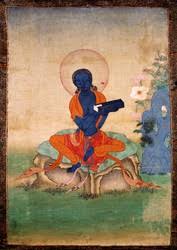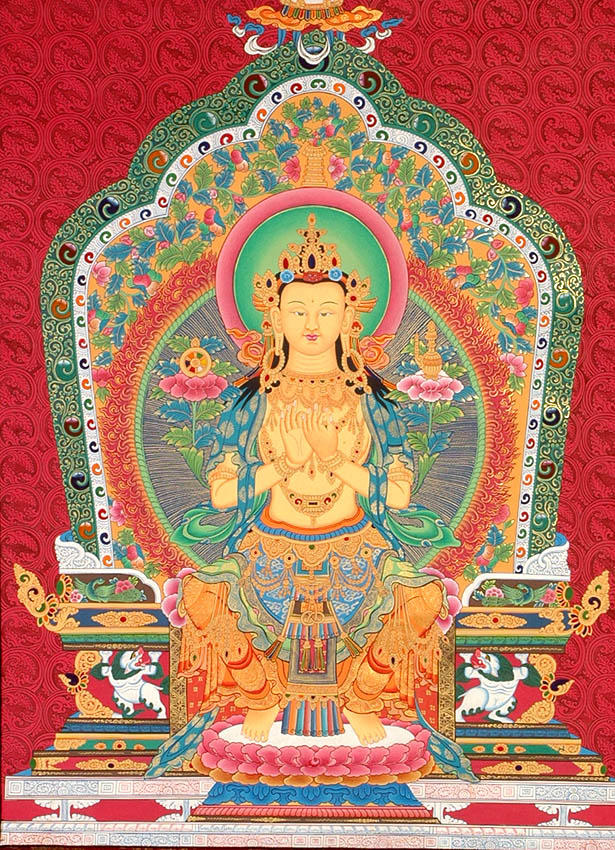 This renowned aspiration is found in Gaṇḍavyūha Sūtra, the last section of the Avataṃsaka Sūtra. The text describes Sudhana's journey to enlightenment, a pilgrimage that results in his direct vision of Samantabhadra, to whom this text is attributed.
This renowned aspiration is found in Gaṇḍavyūha Sūtra, the last section of the Avataṃsaka Sūtra. The text describes Sudhana's journey to enlightenment, a pilgrimage that results in his direct vision of Samantabhadra, to whom this text is attributed.
Rinpoche has often based his explanations on a commentary by Drakpa Gyaltsen, who was a student of Jamyang Khyentse Wangpo.
This commentary is called Compendium of all Eminent Explanations, a Commentary on the Meaning of the Words in the King of Noble Aspirations, the Prayer for Excellent Conduct འཕགས་པ་བཟང་པོ་སྤྱོད་པའི་སྨོན་ལམ་ཚིག་དོན་གྱི་འགྲེལ་བ་ལེགས་བཤད་ཀུན་ལས་བཏུས་པ།
For now, you find teachings from Bouddha from an unknown year, where Rinpoche teaches the text to the ani-las; from April 1991, where Rinpoche first taught the commentary extensively, from Bouddha 1994, Tenerife 1995 and Bouddha 2001.
Tibetan - English
1, 11,2 and 1 talks, audio
 The third Karmapa, Rangjung Dorje, was both a great scholar and an accomplished meditator. In particular, he is known for his great compassion and many miraculous feats, the most famous being the ཀར་སྐུ་ཟླ་ཞལ་མ། the clear manifestation of his face and upper part of his body in the center of the full moon the day after his passing.
The third Karmapa, Rangjung Dorje, was both a great scholar and an accomplished meditator. In particular, he is known for his great compassion and many miraculous feats, the most famous being the ཀར་སྐུ་ཟླ་ཞལ་མ། the clear manifestation of his face and upper part of his body in the center of the full moon the day after his passing.
His aspiration prayer is therefore considered to be of utmost importance and though being a short text, complete in its presentation of all the essential points of mahamudra.
Rinpoche has always introduced this text to all levels of practitioners.
Visiting Kagyu Thubten Chöling in September 1989, Rinpoche taught extensively the 8th Situ Rinpoche's famous commentary on this text called Mahamudra Teachings of the Supreme Siddhas.
For now you will find teachings from Munich 1980, Halscheid and Ludwigshorst May 1986, Kagyu Thubten Chöling, Wappingers Falls 1989, Athens 1990, Crestone 1999, Hawaii 1999, Karma Lodro Ling, Barcelona, April 2000, Munich 2001, London 2001, and Kagyu Thubten Chöling, Wappingers Falls 2002.
Tibetan - English, Tibetan - German, Tibetan - English - Spanish, Tibetan - Chinese Mandarin (中文)
4, 2, 17, 3& 1 talks, audio
 The Noble Maitreya's Aspiration Prayer is found in the forty-first chapter of the Heap of Jewels Sutra, the Mahāratnakūṭa Sūtra, འཕགས་པ་བཀོན་མཆོག་བརྩེགས་པའི་མདོ།
The Noble Maitreya's Aspiration Prayer is found in the forty-first chapter of the Heap of Jewels Sutra, the Mahāratnakūṭa Sūtra, འཕགས་པ་བཀོན་མཆོག་བརྩེགས་པའི་མདོ།
At Marpa House, Bouddha 1994, Rinpoche began to give extensive explanations on this aspiration based on the commentary by the great 19th century Kagyu Master Mendong Tsampa Rinpoche Ngedon Tengye: An Easy and Pleasant Path to Enlightenment བྱམས་སྨོན་འགྲེལ་ཆུང་བྱང་ཆུབ་བདེ་ལམ།
These teachings resulted in an English translation by Michele Martin, which Rinpoche, while touring the world, often offered explanations on for years to come.
For now you will find, Bouddha 1994, Mahamudra Retreat Zentrum Halscheid 1994, Kagyu Thubten Choling 1996, Karma Triyana Dharmachakra 1996, Pullahari 1997, Tenerife 2000, and from Tekchog Ling, Bouddha 2001, where Rinpoche teaches a group of anis.
Tibetan only
Audio
The great Indian Pandita, Shantideva, was living at Nalanda University in the 8th century. Challenged to give a lecture, he spontaneously composed this text, the Bodhisattvacaryāvatāra.
The root verses of the tenth chapter comprise the Aspiration Prayer of the Bodhisattvas.
During the winter of 2000-2001, Rinpoche taught two groups of the ani-las at Tek Chok Ling the Preliminary Practices, the Noble Maitreya's Aspiration Prayer, the Thirty-seven Practices of a Bodhisattva and this Aspiration Prayer of the Bodhisattvas. He combined his explanations on this latter aspiration with the five Buddhist tenets. As a conclusion, Rinpoche taught select verses of the Prayer for Excellent Conduct.
Tibetan only
4 talks, audio